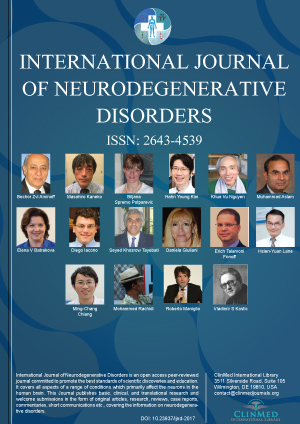
 International Journal of Neurodegenerative Disorders is an open access peer-reviewed journal committed to promote the best standards of scientific discoveries and education. It covers all aspects of a range of conditions which primarily affect the neurons in the human brain. International Journal of Neurodegenerative Disorders publishes basic, clinical, and translational research.
International Journal of Neurodegenerative Disorders is an open access peer-reviewed journal committed to promote the best standards of scientific discoveries and education. It covers all aspects of a range of conditions which primarily affect the neurons in the human brain. International Journal of Neurodegenerative Disorders publishes basic, clinical, and translational research.
International Journal of Neurodegenerative Disorders is newly launched journal which provide author benefits along with reliable copy rights policy. All the articles pass through a dual review process in which two independent review comments followed by editor's decision will be considered to publish the article. Editorial team ensures the maintenance of its standards by publishing the high quality, original and new advances in its field.
The journal welcome submissions in the form of original articles, research, reviews, cases, commentaries, reports, and short communications etc., covering the information on neurodegenerative disorders. The scope of the journal include but not limited to alzheimer's disease and other dementias, parkinson's disease and l.pd-related disorders, prion disease, motor neuron diseases, huntington's disease, spinocerebellar ataxia, spinal muscular atrophy, etc.
Journal Information
Title: International Journal of Neurodegenerative Disorders
ISSN: 2643-4539
Editor-in-chief: Dr. Mohammed Rachidi
NLM title abbreviation: Int J Neurodegener Dis
ISO abbreviation: Int J Neurodegener Dis
Other titles: IJND
Category: General Medicine
DOI: 10.23937/2643-4539
Peer review: Double blind
Review speed: 3 weeks
Fast-track review: 10 days
Publication format (s): Electronic and print
Publication policy: Open Access; COPE guide
Publication type(s): Periodicals
Publisher: ClinMed International Library
Country of publication: USA
Language: English
Contact email: contact@clinmedjournals.org
Articles Search by Keyword | Journal title | Author name | DOI
Open Access DOI:10.23937/2643-4539/1710025 Lisette Blanco-Lezcano, María Elena González-Fraguela, Guadalupe Zaldívar-Lelo de Larrea, Rosa Martha Pérez-Serrano, María Daniela Frade-Pérez, Teresa Serrano-Sánchez and Liliana Francis Turner Article Type: Original Article | First Published: 2023/04/14 The hypothesis that early degeneration of the pedunculopontine nucleus (PPN) may be related to nigral degeneration has opened new avenues of basic research for this disease. It is not known how the motor function and nigrostriatal gene expression of TH, VMAT2 and DAT behave in an intermediate term (30 days) following the pontine lesion....
| |
Open Access DOI:10.23937/2643-4539/1710023 Mohammed Rachidi Article Type: Research Article | First Published: July 04, 2022 Down syndrome (DS) is the most frequent genetic disease characterized by several neuropathological features including alteration in neurogenesis, mental disability, cognitive impairments, learning-memory deficits and early onset of Alzheimer’s disease (AD). Over expression of chromosome 21 genes, localized in Down Syndrome Critical Region (DSCR), is the main cause of DS neuropathological features. We studied herein one of DSCR genes, DYRK1A (Dual-Specificity Tyrosine-Phosphorylation-Regulated ...
| |
Open Access DOI:10.23937/2643-4539/1710022 Cognitive Decline in Parkinson's Disease: Theories and Implications for Rehabilitation Katherine A Brown, PhD, CCC-SLP, CBIS, Dale KL Summers, MS, CCC-SLP and Kristie A Spencer, PhD, CCC-SLP Article Type: Review Article | First Published: March 30, 2022 Cognitive changes in Parkinson’s disease (PD) can occur at any stage of the disease and have been shown to significantly impact well-being and life participation. The nature and pattern of cognitive decline in PD remains unclear due to the heterogeneity of symptoms and lack of a clear explanatory model. This review aims to draw attention to several theoretical models of cognitive decline in PD to deepen our understanding of the complex milieu of symptoms and begin to offer clinical implication...
| |
Open Access DOI:10.23937/2643-4539/1710021 Attitudes Toward People with Epilepsy in Libya, the Conundrum Continues! Ashraf M Rajab Article Type: Commentary | First Published: September 11, 2021 A close and contemplative look at the published neurology literature makes it clear to the reader that epilepsy research possesses more popularity and occupies a higher position in the plethora of scholarly medical writings. Perhaps the reason behind this is that epilepsy nowadays has become more than just transient seizures that are treated with drugs to put an end to seizure recurrence, but rather it is a disease that permeates all aspects of the patient's life. Epilepsy affects not only the p...
| |
Open Access DOI:10.23937/2643-4539/1710020 Troy T Rohn, James D Beck, Stephanie J Galla, Noail F Isho, Tanner B Pollock, Tarun Suresh, Arni Kulkarni, Tanya Sanghal and Eric J Hayden Article Type: Research Article | First Published: September 10, 2021 The apolipoprotein E4 (APOE4) allele represents the single greatest risk factor for late-onset Alzheimer’s disease (AD) and accumulating evidence suggests that fragmentation with a toxic-gain of function may be a key molecular step associated with this risk. Recently, we demonstrated strong immunoreactivity of a 151 amino-terminal fragment of apoE4 (E4-fragment) within the nucleus of microglia in the human AD brain. In vitro, this fragment led to toxicity and activation of inflammatory process...
| |
Open Access DOI:10.23937/2643-4539/1710019 Clinical and Pre-Clinical Evidence for Enteric α-Synuclein Involvement in Parkinson’s Disease Eliyahu M Kochman, BS, Kainat Akhtar, BS, Ali Alelayawi, BS and Damian S Shin, MS, PhD Article Type: Research Article | First Published: May 08, 2021 Parkinson’s disease (PD) is the second most common neurodegenerative disease, presenting with the loss of dopaminergic neurons in the substantia nigra pars compacta (SNpc) and motor symptoms. Categorized as a synucleinopathy, the pathological hallmark of PD is intracellular filamentous Lewy bodies (LB), which are formed from protopathic aggregates. The most prevalent of these proteins is the presynaptic protein ɑ-synuclein (α-syn). While commonly attributed to neuronal death in SNpc, postmor...
| |
Open Access DOI:10.23937/2643-4539/1710018 Alzheimer’s Disease: Beyond A Genetic Disease Mostafa Showraki, MD, FRCPC Article Type: Research Article | First Published: January 16, 2021 Alzheimer’s disease (AD), the most common type of dementia or neurodegenerative diseases since the beginning of the past century when it was coined by the German psychiatrist, Alois Alzheimer in 1901 holds an allusive etiology, and as a result failed most treatment and prevention strategies. Despite the common belief among the experts of AD being a genetic disease, the genetic heritability of this disease has such a wide range of 50-80% in twin and family studies that questions the totality of...
| |
Open Access DOI:10.23937/2643-4539/1710017 Immunomodulating, Neuroprotective and Regenerative Modalities in Multiple Sclerosis Management Mike KS Chan, Michele Zocchi, Dina Tulina, Anam K Kour, Lau Cher Rene, Roni Moya and Michelle WB Fah Article Type: Review Article | First Published: September 10, 2020 The phenomenon of “Westernization” in Asian countries which includes a specific choice of food and lifestyle was related to the higher prevalence of MS in Asia’s population which almost supports new findings on the great influence of gut and its microbiota in people worldwide. The current conventional therapy helps to prolong the periods between attacks and relapses, but in fact, does not slow down the disease progression and impact on physical activities which eventually leads to disabili...
| |
Open Access DOI:10.23937/2643-4539/1710016 Omid Mohamadi and Farhad Torabinezhad Article Type: Case Report | First Published: June 01, 2020 The patient was a 64-year-old man with movement disorder and dysarthria, which was referred to the Speech Therapy Clinic of Hazrat Rasoul Hospital affiliated with Iran University of Medical Sciences. The level of education of the patient was PhD in political science and his job was to teach part-time at the university as well as high school management. The onset of obvious symptoms in this patient dates back to about 4 years and 7 months ago. At that time, he was not able to keep the names of hi...
| |
Open Access DOI:10.23937/2643-4539/1710015 Jessica Leika R Matibag, MD , Eri Uematsu, MD, and Cid Czarina Diesta, MD, FPNA Article Type: Original Researc h | First Published: April 11, 2020 Spinocerebellar ataxia 2 is a rare neurodegenerative disease characterized by a complex neurological presentation of ataxia of adult onset with an autosomal dominant inheritance caused by an abnormal expansion of trinucleotide CAG repeat. The aim of this study is to determine the correlation of CAG trinucleotide repeat length with Scale for assessment and rating of ataxia score, age of onset and disease duration among genetically-positive individuals....
| |
Open Access DOI:10.23937/2643-4539/1710014 Kristie A Spencer, Clare Friedlander and Katherine A Brown Article Type: Researc h Article | First Published: January 03, 2020 The motor and non-motor deficits of Parkinson’s disease (PD) can cause daily challenges and have been associated with reduced health-related quality of life (HrQoL). A number of variables have been consistently, though not unequivocally, identified as important in influencing overall HrQoL in individuals with PD, such as demographic factors, cognitive decline, and level of motor impairment. However, the presence and severity of dysarthria is often overlooked, despite the potentially adverse in...
| |
Open Access DOI:10.23937/2643-4539/1710013 Part Two: Habit and Customs, Obesity and Parkinson's Disease Muslimat Kehinde Adebisi, Li Xuezhong, Ehianeta Teddy and Liuyi Article Type: Review Article | First Published: October 21, 2019 Keyword used in searching for similar articles on PubMed were, Obesity, hyperlipidemia, Metabolic syndrome (MetS), Neurodegenerative disorders, Parkinson’s diseases (PD). Papers from 2014-2019 related were compiled. Cases at Zhenjiang First people’s hospital similar was compiled to draw conclusions. I evaluated the association between years of diagnosis (YOD) of PD and BMI for both male and female patients and compared to controlled groups. There was a statistically significance between YOD ...
| |
Open Access DOI:10.23937/2643-4539/1710012 Muslimat Kehinde Adebisi, Ehianeta Teddy, Mzee Said Abdulraman Salim, Liuyi, Abdul Nazif Mahmud, Aaron Gia Kanton and Abdullateef Taiye Mustapha Article Type: Research Article | First Published: October 14, 2019 Currently Parkinson's disease is becoming more common among younger people of ages from 30-40 years. The incidence is higher among patients with higher BMI, some reports has it that Obesity is a risk factor for Parkinson’s disease while some reported that there is no relationship between obesity and Parkinson’s disease. Parkinson’s disease patient at the time of diagnosis has a above normal BMI but this goes below normal as the disease progresses. Therefore, it is important to explore the ...
| |
Open Access DOI:10.23937/2643-4539/1710011 Nilufer Esen, Rakhi Sharma, James P Malleis and Paula Dore-Duffy, Ph.D Article Type: Research Article | First Published: September 18, 2019 The mammalian brain depends on a continuous supply of oxygen and glucose to meet metabolic demand. Adaptive mechanisms allow brain cells to exist under conditions of moderately low oxygen when ‘idling’ or exposure to high altitude as well as elevated oxygen delivery when activated. Regulation involves numerous intrinsic and extrinsic adaptive mechanisms that serve to maintain metabolic homeostasis. Under conditions of chronic low oxygen (10%) endogenous changes in CNS angiodynamics help prom...
| |
Open Access DOI:10.23937/2643-4539/1710010 Deeksha Kaloni and Abhishek Negi Article Type: Review Article | First Published: September 18, 2019 Alzheimer is one of the most common causes of dementia that influence nerve cells in various parts of the brain. Pathologically it is caused because of intracellular neurofibrillary tangles and extracellular amyloidal protein and results in the deposition of plaques which obstruct the communication between the nerve cells resulting in this neurodegenerative disease. The genetic risk factor found to be associated with this disease is mutation in APP, PSEN1 and PSEN2 genes. Also, the diet and nutr...
| |
Open Access DOI:10.23937/2643-4539/1710009 Acute Cognitive Effects of Physical Activity for People who have Dementia Jordan Elliott-King, Elizabeth Peel and Eef Hogervorst Article Type: Original Article | First Published: August 01, 2019 Physical activity has the potential to improve cognition for those with dementia, as demonstrated by randomised controlled trials lasting at least 6 weeks. Research is yet to explore the acute cognitive effects of physical activity for people with dementia. Acute resistance physical activity with healthy late-middle aged individuals has been shown to facilitate general cognition, as well as benefit executive function specifically. This study therefore aimed to establish if people with dementia e...
| |
Open Access DOI:10.23937/2643-4539/1710008 Peter L Heller, PhD, David F Briones, MD, James A Wilcox, MD, PhD and Jose Manuel de la Rosa, MD Article Type: Research Article | First Published: July 11, 2019 We report logistic regression analyses findings from a community sample of elderly Mexican Americans and non-Hispanic whites demonstrating that degrees of associations between diabetes and PD with CImp persist after controlling for effects of functional decline. However, after adding effects of a number of control variables (including ethnicity) to the equation, association between diabetes and CImp is no longer significant. We suggest that these findings may well be an artifact of the high prev...
| |
Open Access DOI:10.23937/IJND-2017/1710007 Identification of PSEN1 and PSEN2 Gene Variants and Clinical Findings with the Literature Nadide Cemre Randa, Elçin Bora, Esra Ataman, Ozlem Oz, Gorsev Yener and Ayfer Ulgenalp Article Type: Original Article | First Published: April 11, 2019 Alzheimer's disease is an age-related and irreversible disease and characterized progressively decline in cognitive functions such as memory, speech, executive functions and visual-spatial skills. Currently, there is no a simple and definitive diagnosis method for clinical management. It is possible to diagnose with 85-90% accuracy with clinical assesment and neuropsychological tests. The precisely-known risk factors associated with Alzheimer's disease are aging, family history, and the presence...
| |
Open Access DOI:10.23937/IJND-2017/1710006 Abhilasha Surampalli, Angele Nalbandian, Sandra Donkervoort, Manaswitha Khare, Annabel Wang, Rudolph Castellani, Hong Yin, Ana Rubio, Payal Patel, John Weiss, Tahseen Mozaffar and Virginia E Kimonis Article Type: Case Report | First Published: December 19, 2018 Valosin Containing Protein (VCP) gene mutations have been reported in ~1-2% of familial amyotrophic lateral sclerosis (ALS). We report a case of clinically defined and neuropathologically confirmed ALS in a 48-year-old, emaciated female with a p.R155C (c.463 C > T) mutation in VCP gene. She presented with progressive generalized muscular weakness, weight loss, dyspnea on exertion, combined nasal and spastic dysarthria, positive jaw jerk and exaggerated gag reflex. Electrodiagnostic studies revea...
| |
Open Access DOI:10.23937/ijnd-2017/1710005 Rare and Hereditary Causes of Stroke-A Literature Review Eyisi CS, Onwuekwe IO, Eyisi IG and Ekenze O Article Type: Research Article | First Published: November 19, 2018 A stroke is a Focal (or global) neurological impairment of sudden onset, lasting more than 24 hrs and usually from a vascular cause. Clinical presentation span through a myriad of motor deficits, sensory deficits, seizures, personality/behavioral anomalies, dementia, brainstem stroke syndromes and herniation syndromes. Traditionally stokes are classified as ischemic or hemorrhagic, the former more common than the latter in a ratio of 6:1. Conventional risk factors for stroke occurrence have al...
| |
Open Access DOI:10.23937/IJND-2017/1710004 Jeffrey T Apter, Ivy A Billones and Kaylee White Article Type: Case Report | First Published: November 16, 2018 A 69-year-old Caucasian female experienced multiple episodes of full-body tremors during the extension phase of the clinical study. The investigational drug was taken in the mornings. The patient reported that the AE started six months prior with episodes occurring 1-2 times per week eventually escalating almost daily and was more apparent during midnight hours and upon waking up. Further review of previous progress notes states that the patient denied the AE and even stated full compliance and ...
| |
Open Access DOI:10.23937/ijnd-2017/1710003 David A Steenblock, Taruna Ikrar, Andrew S San Antonio, Elfi Wardaningsih and Masoud J Azizi Article Type: Research Article | First Published: September 12, 2018 Amyotrophic Lateral Sclerosis (ALS) or Lou Gehrig's disease is a neurodegenerative and neuromuscular disorder characterized by a progressive death of motor neurons & motor paralysis that culminates in death, usually within 3-5 years of diagnosis from respiratory failure due to paralysis. Currently approved ALS therapies are not curative and fail to increase healthy lifespan. The worldwide prevalence of ALS is expected to increase by 69% over the next 25 years, yet its etiology remains scientific...
| |
Open Access DOI:10.23937/ijnd-2017/1710002 Apolipoprotein E Fragmentation within Lewy Bodies of the Human Parkinson's Disease Brain Troy T Rohn and Jacob M Mack Article Type: Research Article | First Published: February 23, 2018 Although harboring the Apolipoprotein E4 (APOE4) allele is a well-known risk factor in Alzheimer's disease (AD), whether a similar risk holds true for Parkinson's disease (PD) is currently not known. To investigate whether apoE pathology is present in PD, an immunohistochemical study was undertaken with fixed, human PD brain sections from the substantia nigra utilizing a recently characterized antibody that detects an amino-terminal fragment of apoE. This antibody, termed the apoE cleavage fragm...
| |
Open Access DOI:10.23937/ijnd-2017/1710001 Ammarah Y Soofi, Michelle E Kho, Vanina Dal Bello-Haas and Lori Letts Article Type: Review Article | First Published: October 28, 2017 Many factors can affect a person's outlook on his/her life; rehabilitation interventions vary greatly and little is known about the effect of rehabilitation to maintain and/or enhance Quality of Life (QoL) in people with Amyotrophic Lateral Sclerosis (ALS)....
|
Editor-in-chief

ClinMed Archive
7
5
5
9
Articles Published
All articles are fully peer reviewed, free to access and can be downloaded from our ClinMed archive.
Contact our editorial office
ClinMed Journals Index Copernicus Values
Clinical Medical Image Library: 93.51
International Journal of Critical Care and Emergency Medicine: 92.83
International Journal of Sports and Exercise Medicine: 91.84
International Journal of Womens Health and Wellness: 91.79
Journal of Musculoskeletal Disorders and Treatment: 91.73
Journal of Geriatric Medicine and Gerontology: 91.55
Journal of Infectious Diseases and Epidemiology: 91.55
Clinical Medical Reviews and Case Reports: 91.40
International Archives of Nursing and Health Care: 90.87
International Journal of Ophthalmology and Clinical Research: 90.80
International Archives of Urology and Complications: 90.73
Journal of Clinical Nephrology and Renal Care: 90.33
Journal of Family Medicine and Disease Prevention: 89.99
Journal of Clinical Gastroenterology and Treatment: 89.54
Journal of Dermatology Research and Therapy: 89.34
International Journal of Clinical Cardiology: 89.24
International Journal of Radiology and Imaging Technology: 88.88
Obstetrics and Gynaecology Cases - Reviews: 88.42
International Journal of Blood Research and Disorders: 88.22
International Journal of Diabetes and Clinical Research: 87.97
New Issues

